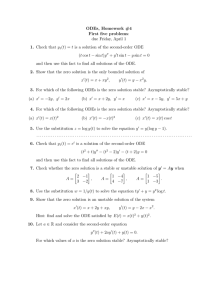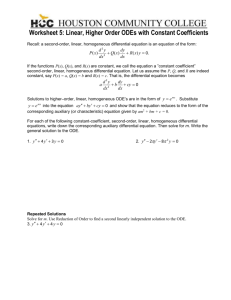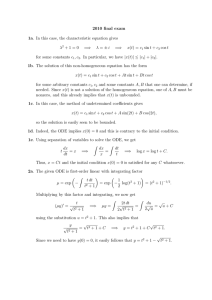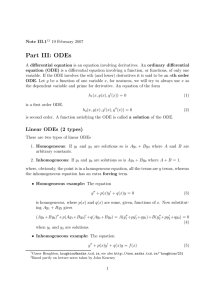2009 final exam 1a 1b 1c
advertisement
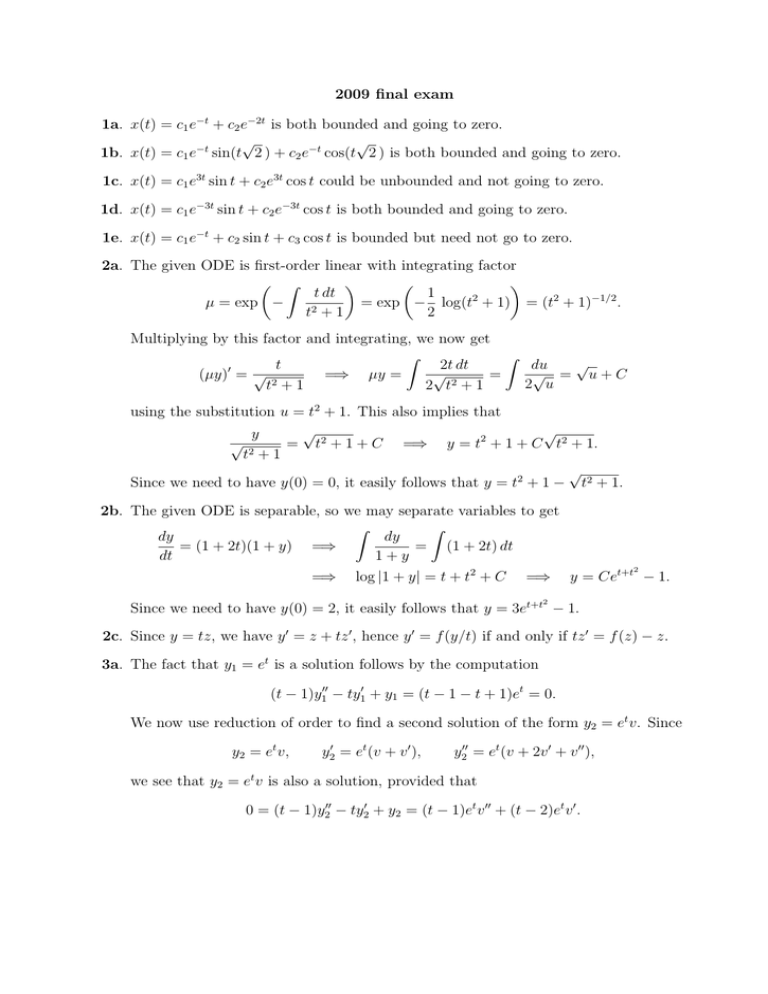
2009 final exam 1a. x(t) = c1 e−t + c2 e−2t is both bounded and going to zero. √ √ 1b. x(t) = c1 e−t sin(t 2 ) + c2 e−t cos(t 2 ) is both bounded and going to zero. 1c. x(t) = c1 e3t sin t + c2 e3t cos t could be unbounded and not going to zero. 1d. x(t) = c1 e−3t sin t + c2 e−3t cos t is both bounded and going to zero. 1e. x(t) = c1 e−t + c2 sin t + c3 cos t is bounded but need not go to zero. 2a. The given ODE is first-order linear with integrating factor ( ) ( ∫ ) 1 t dt 2 = exp − log(t + 1) = (t2 + 1)−1/2 . µ = exp − 2 t +1 2 Multiplying by this factor and integrating, we now get ∫ ∫ √ t 2t dt du ′ √ = u+C √ (µy) = √ =⇒ µy = = 2 u t2 + 1 2 t2 + 1 using the substitution u = t2 + 1. This also implies that √ √ y √ = t2 + 1 + C =⇒ y = t2 + 1 + C t2 + 1. t2 + 1 √ Since we need to have y(0) = 0, it easily follows that y = t2 + 1 − t2 + 1. 2b. The given ODE is separable, so we may separate variables to get ∫ ∫ dy dy = (1 + 2t)(1 + y) =⇒ = (1 + 2t) dt dt 1+y 2 =⇒ log |1 + y| = t + t2 + C =⇒ y = Cet+t − 1. Since we need to have y(0) = 2, it easily follows that y = 3et+t − 1. 2 2c. Since y = tz, we have y ′ = z + tz ′ , hence y ′ = f (y/t) if and only if tz ′ = f (z) − z. 3a. The fact that y1 = et is a solution follows by the computation (t − 1)y1′′ − ty1′ + y1 = (t − 1 − t + 1)et = 0. We now use reduction of order to find a second solution of the form y2 = et v. Since y2 = et v, y2′ = et (v + v ′ ), y2′′ = et (v + 2v ′ + v ′′ ), we see that y2 = et v is also a solution, provided that 0 = (t − 1)y2′′ − ty2′ + y2 = (t − 1)et v ′′ + (t − 2)et v ′ . Dividing through by (t − 1)et gives a linear ODE with integrating factor ) (∫ ) (∫ 1 et t−2 µ = exp dt = exp 1− dt = . t−1 t−1 t−1 We now multiply by this factor and we integrate to get (µv ′ )′ = 0 =⇒ v ′ = C1 /µ = C1 e−t (t − 1). Using this fact and an integration by parts, we conclude that ∫ v = C1 e−t (t − 1) dt = −C1 te−t + C2 =⇒ y2 = −C1 t + C2 et . 3b. To find the homogeneous solution yh , we note that λ3 − λ2 − λ + 1 = 0 =⇒ =⇒ =⇒ λ2 (λ − 1) − (λ − 1) = 0 (λ − 1)(λ − 1)(λ + 1) = 0 yh = c1 et + c2 tet + c3 e−t . Based on this fact, we now look for a particular solution of the form yp = Ate−t . Differentiating this expression three times, one finds that yp′ = Ae−t (1 − t), yp′′ = Ae−t (t − 2), yp′′′ = Ae−t (3 − t). In particular, yp′′′ − yp′′ − yp′ + yp = 4Ae−t and this implies A=1 =⇒ yp = te−t =⇒ y = c1 et + c2 tet + c3 e−t + te−t . 4a. First of all, we compute the eigenvalues of the associated matrix, namely [ ] a 1 A= =⇒ λ2 − 2aλ + (a2 − 1) = 0 =⇒ λ = a ± 1. 1 a If a < −1, then both eigenvalues are negative and the zero solution is asymptotically stable. If a > −1, then one eigenvalue is positive and the zero solution is unstable. In the remaining case a = −1, the eigenvalues are λ = −2, 0 and the zero solution is stable but not asymptotically stable. 4b. Note that V is positive definite with V ∗ (x, y) = 2xx′ + 2yy ′ = −2x2 + 4xy − 2ay 2 = −2(x − y)2 + 2(1 − a)y 2 . It easily follows that V is a strict Lyapunov function if and only if a > 1. 5a. Consider any two solutions of the ODE, say yi and yj . Subtracting the equations yi′′ + pyi′ + qyi = r, yj′′ + pyj′ + qyj = r, one finds that yi − yj satisfies the associated homogeneous ODE. Thus, each of y2 − y1 = 2e−t , y3 − y1 = e2t is a solution of the homogeneous ODE, so these two functions must actually generate the space of all solutions. In other words, every solution of the homogeneous ODE y ′′ + py ′ + qy = 0 has the form y = c1 e−t + c2 e2t . This means that λ1 = −1 and λ2 = 2 are such that λ2 + pλ + q = 0 =⇒ p = −(λ1 + λ2 ) = −1, q = λ1 λ2 = −2. Since y1 = et is a solution of the non-homogeneous ODE, we also have r = y1′′ + py1′ + qy1 = et − et − 2et = −2et . 5b. We examine the roots of the associated quadratic equation √ −b ± b2 − 4c 2 λ + bλ + c = 0 =⇒ λ = . 2 • If these roots are real, then they are both negative because √ b2 − 4c < b2 =⇒ b2 − 4c < b. Since the solution is either c1 eλ1 t + c2 eλ2 t or c1 eλ1 t + c2 teλ1 t and the λi ’s are negative, the solution does go to zero as t → ∞. • If the roots are not real, then we have λ = − 2b ± iγ for some γ ∈ R and so y(t) = c1 e−bt/2 sin(γt) + c2 e−bt/2 cos(γt). Since b > 0 by assumption, however, the solution still goes to zero as t → ∞.

